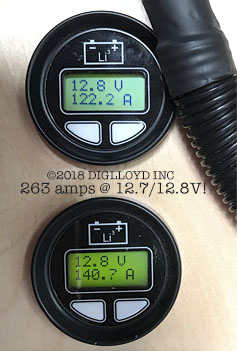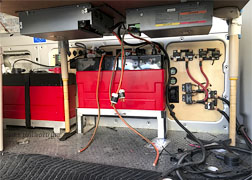10 Kilowatt Battery System in Mercedes Sprinter Delivers 263 amps @ 12.7/12.8V (dual Lithionics 400-amp batteries, dual Xantrex Freedom XC Inverter/Charger)
See subsequent updates...
...
Now installed in my Mercedes Sprinter photography adventure van are dual 400-amp 5 kW Lithionics batteries wired in parallel, with dual Xantrex Freedom XC 2000W power inverter/chargers for DC-AC conversion.
Installed by ADF Sprinters in San Fernando, CA.
Shown below, two space heaters together are 3350 watts. All connections are doubled-up (each batter and inverter gets its own 4/0 cable). Circuit board and battery terminals do not even get warm under this massive load.
These being ultra high grade lithium iron phosphate batteries, both specifications and real-world field use prove that 90% discharge is fine (10% state of charge remaining), though I try to keep it to 15% SoC. Each battery by itself is rated to discharge at 400 amps and to charge at 360 amps—so even at 260 amps, my system uses only a fraction of the maximum capability.
Continues below...

Asymmetric amperage bug
Update: I’ve diagnosed the issue. With an asymmetric load, nearly all the current was flowing along just one of the 4/0 cables, with “juice” from the other battery flowing through the hot/red terminal tie (4/0 about 10 inches). Up to a 2X differential draw was observed, though that was atypical with a 20% differential more typical. The solution is to tie the two pairs of breakers together, determined by pressing a piece of 1/0 cable against the terminals whose ends were a mass of copper fibers—I could regulate amperage out of the one battery by up to 40 amps just by how hard I pressed the two cable stubs against the terminals. A short tie will be added to do that at all times, tying 4 circuit breakers together (two breakers in two pairs).
... original description follow ...
One performance bug as seen above is asymmetric power draw from the two batteries, which can be up to about 25% difference in amperage, depending on load. The same asymmetry is seen when charging with the alternator, which reverses the charging path, but leaves the inverters out of the equation. Therefore, the behavior must not be related to the cabling from the circuit board to the inverters but between the battery and the circuit board. There is nothing obvious as to the cabling as to why this would happen, see the notes below on cabling.
The behavior results in a steady deviation in SoC (State of Charge), for example 57% vs 63%. With zero load, amps bleed from the higher SoC battery to the lower SoC battery, starting at as high as 7 amps if there is a substantial difference in SoC then settling down to half an amp or so after 18 hours. In other words, the two batteries equalize until the voltage matches, but this can still leave a 4% SoC difference.
The asymmetry flips if inverter #2 is used instead of inverter #1. For example, if battery #1 is supplying 20% more amps, then switching the load to the other inverter flips so that battery #2 supplies 20% more amps. That suggests that the cabling supplies a lower path of resistance to each inverter/battery pair (inverter #1 cables to the hot terminal of battery #1, inverter #2 cables to the hot terminal of battery #2)—but the hot terminals of the two batteries are tied to together with 4/0 cable of about 10 inches in length—this should effectively make the two batteries into one battery. But clearly something more complex is going on. Perhaps the grounding cables are involved (also 4/0).
This behavior needs to be debugged and possible another 4/0 cable tying the two batteries together (positive and/or negative) might be needed to equalize whatever is causing the imbalance.
Wiring
A more detailed report to follow as time allows.
Below, part way through the install process. The table as shown is temporary and will be replaced in a few weeks by a 1.5-inch-thick hickory butcherblock table. The inverters will then be spaced apart another 6 inches or so.
This was a tricky design process in which a few space problems cropped up we had not thought of—a 144-inch wheelbase Sprinter leaves little room to place both batteries along with wiring and outlets, etc, at least for my requirements. But it is now down and fully functional. This is the most capable battery system (by far) ever installed by ADF Sprinters (they do about 280 Sprinters a year).
Key points:
- Positive and negative cables from battery terminals are 4/0 gauge. That stuff is braided copper which itself is 11.68mm = 0.46 inches in diameter — not easy to work with.
- Positive terminals of the two batteries are tied together with a short length of 4/0 cable.
- Cables to inverters and on circuit board are also 4/0.
- The charging cables from alternator are dual 1/0 (equivalent to one 4/0). This is more than ample for the peak amperage from the alternator (up to about 138 amps). Dual cables puts half the load on the contact terminals, dual solenoids and breakers cut the amperage to each in half, thus keeping amps at less than half what the 150-smp solenoids are rated for—I wanted it over-engineered.
- Double everything: inverters, cables from alternator, solenoids, breakers, batteries, status gauges—over-engineered for reliability under extreme load.
- Each inverter/charger plus into shore power separately (8 AWG from shore power inlet to central outlet above the two dangling plugs). This was done so that a 15 amp outlet could be used by unplugging one inverter/charger (together they pull up to 19 amps = 2300 watts which would fry a 15 amp circuit).
- The inverter/chargers when shore-powered by a 30 amp circuit can charge at nearly 160 amps DC.










